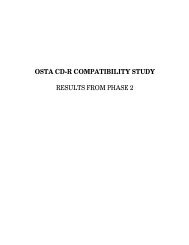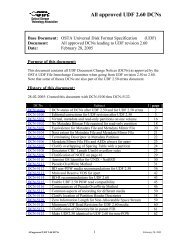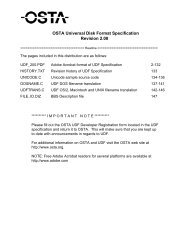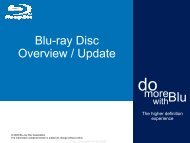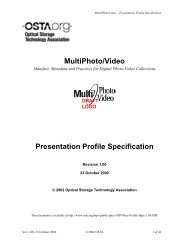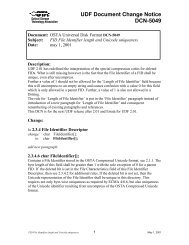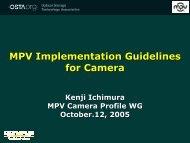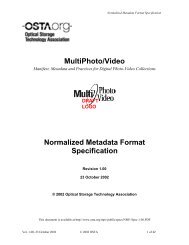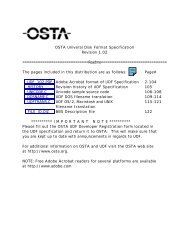here - OSTA - Optical Storage Technology Association
here - OSTA - Optical Storage Technology Association
here - OSTA - Optical Storage Technology Association
Create successful ePaper yourself
Turn your PDF publications into a flip-book with our unique Google optimized e-Paper software.
“*UDF Non-Allocatable Space”<br />
The stream shall be marked with the attributes Metadata (bit 4 of file characteristics set to<br />
ONE) and System (bit 10 of ICB flags field set to ONE). This stream shall have The<br />
stream's allocation descriptors shall identify all Non-Allocatable sectors identified by its<br />
allocation extents. non-allocatable packets. The allocation extents shall indicate that each<br />
extent is descriptors shall have allocation type 1 (allocated but not recorded. ). This<br />
liststream shall include both defective sectorspackets found at format time and space<br />
allocated for sparing at format time.<br />
NOTE: For packetized media all blocks of a packet containing a defect should be<br />
allocated to the Non-Allocatable Space Stream.<br />
3.3.7.3 Power Calibration Stream<br />
One of the potential limitations on the effective use of the packet-write capabilities of<br />
CD-Recordable drives is the limited number (100) of power calibration areas available on<br />
current CD-R media. These power calibration areas are used to establish the appropriate<br />
power calibration settings with which data can be successfully and reliably written to the<br />
CD-R disc currently in the drive. The appropriate settings for a specific drive can vary<br />
significantly from disc to disc, between two different drives of the same make and model,<br />
and even using the same disc, drive and system configuration, but under different<br />
environmental conditions.<br />
Because of this, most current CD-R drives recalibrate themselves the first time a write is<br />
attempted after a media change has occurred. This imposes no restriction on recording to<br />
discs using the disc-at-once or track-at-once modes, since in each of these modes the disc<br />
will fill (either by consuming the total available data capacity or total number of<br />
recordable tracks) in less than 100 separate writes. When using packet-write though, the<br />
disc could be written to thousands of times over an extended period before the disc is full.<br />
Suppose, for instance, one wanted to incrementally back-up any new and/or modified<br />
files at the end of each work day (though the drive might also be used intermittently to do<br />
other projects during the day). These back-ups may require writing as little as a megabyte<br />
(or even less) each day. If one of the power calibration areas is used to calibrate the drive<br />
before writing to the disc every day, within five months the power calibration areas will<br />
all have been used, but only a small fraction of the total disc capacity will have been<br />
consumed. It is likely that such a result would be both unexpected and unacceptable to<br />
the user of such a product.<br />
The industry is attempting to provide ways to reduce the frequency with which the power<br />
calibration area of a CD-Recordable disc must be used. At least one current CD-R drive<br />
model tries to remember the power calibration values last used for recording data on each<br />
of a small number of recently encountered discs. Most CD-Recordable drives provide a<br />
UDF 2.01<br />
92<br />
March50 April



